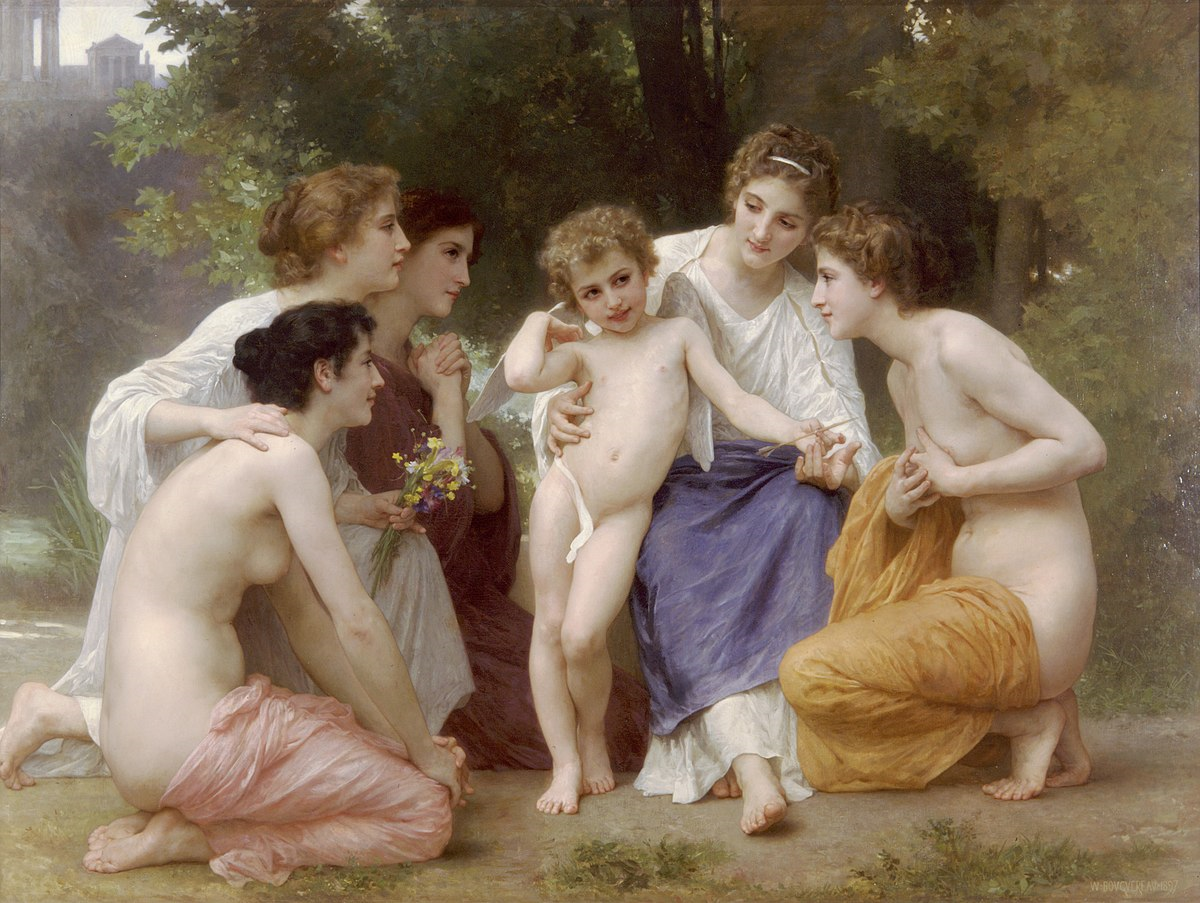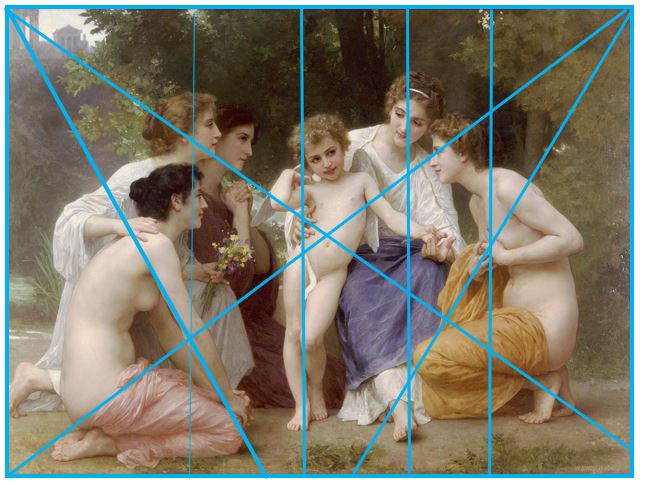

Introduction
Scale and Proportion
William Adolphe’s Admiration artwork is a 147 ×200 centimeters painting of oil on canvas. The painting is located at the San Antonio museum in the United States. It depicts six figures who are most likely siblings placed in a foreground of a tree shrub. The figures cover about 80% of the painting. In the background the artist illustrates a tree with sprouting seedlings and stems, creating a bush-like context (Art Renewal Center). One lady is sited while the other four squatting around the boy, giving him full attention. Two ladies are half-dressed with colorful robes hanging on their lower bodies. Two other ladies are fully clad in white dresses accentuating the light reflection. One lady on the back left is kneeling down with hands clenched in a praying position as the lady next to her holds a bunch of colorful flowers (Art Renewal Center). The artist has used color, line, and lighting techniques to illustrate innocence, something that is imperceptible at first view.
Lighting and Texture
The major illumination source in Admiration emerges from a position above the right side of the canvas, glaring downwards at the young boy and two ladies on the right. The child’s hair is reflected as he bends over the lady in the back right, forming a halo effect and emphasizing his innocence. The illumination on the woman’s white dress and shoulders highlights depicts her as a greater focal point, reinforcing her significance throughout the painting (Art Renewal Center). The lighting, which creates an aura that connects childhood with the potential, counteracts claims that the artist was excessively sentimental. Rather, it has the opposite impact, as Bouguereau’s flawless finishing, smooth texture, and velvety tone, which bathed everything he saw in a single view, had the impact of disassociating feelings and emotions by strategy. Two other points of light are; to the west, in the cluster of branches, a vertical light creates a three-dimensional effect by creating the impression of depth.
Emphasis
The lighting on this leaf cluster emphasizes the simplicity of nature while still implying that it is pure and innocent, much like a child. A vertical illumination on the back right exposes the background contents. Bouguereau’s placing of this background light on the right clears any negative sentiments from the artwork, providing further visual stimuli for the audience. The light sources work together to shape and unify the image, as well as to concentrate the viewer’s attention on important parts of the painting.
Line and Space
Bouguereau also illustrates a special interest in positioning the child to create the best impression of movement. He creates paintings out of the action of solid, well-rounded figures, whose authoritarian presence floods the murals with energy. In Admitation, the boy’s gently folded right hand is lifted over his shoulder, forming three diagonal lines that suggest motion (Art Renewal Center). His legs, especially his right leg, which is stretched but slightly bent back, create a sharp parallel line, evoking a sense of activity. The boy’s other arm is outstretched and clenched by the highlighted woman on the back right, creating a three-dimensional view and a sense of mobility. The boy’s stance, on the other hand, forms a small triangular shape with her shoulder, outstretched hand, and feet folded underneath her, rendering her the central focus. Bouguereau often cleverly aligned the boy’s extended hand and twisted left knee, emphasizing a figurative association (Art Renewal Center). Bouguereau frequently illustrated siblings to emphasize his appreciation of the material for his artworks of youngsters allowed for the manifestations of morals that established, for the artist, the core of his worldview: youthful optimism, the comfort of a family community, and fraternal love. Bouguereau’s design reflects his love of sibling relationships and his admiration for children, and the use of lighting in the artwork underscores this.
Use of Color and Repetition
Bouguereau’s utilization of color is his most prominent attribute as an artist, and it was his personal innovation. The Academie concentrated solely on painting, which was regarded as instructive, while color was not taught, but was regarded as a strategically personal subject. Coloring is not an innate characteristic, it is learned or developed. The painting’s youngsters are flushed in vibrant colors to highlight their vivacity and lure viewers. For instance, the ladies’ outfits are decorated with rich teal and lavender hues, bolstered by the warm colors of white and yellow (Art Renewal Center). The vibrant colors reverberate off one another, luring a viewer in. The ladies embody youthful vitality with revealing smooth skin and well-kept hair.
The baby, on the other hand, is naked and his nudity lends him an innocence distinct from that of a female, angelic in appearance and imbuing notions of modesty with an emphasis on body coloring, eliciting a bloom of the boy’s cheeks, hair, and arms. Infused pink coloring adorns the child’s forehead, giving it a flushed appearance, as though he’s smiling (Art Renewal Center). His arms still have saturated pink color and reds blended into subdued whites to indicate movement, as though the child is pushing away the foliage from a flower the girl on the back left keeps close to her chest. His hair is a multicolored layer of browns, orange, and yellow with varying degrees of intensity to offer it depth, glitter, and vitality. Bouguereau’s love and adoration of children, especially the boy child of the painting is evident in his dedication to his hair.
Balance
The skins of the ladies and the boy are carefully blended in a somewhat milky white shade, with some pale blue shimmer applied to provide the impression of veins and subtle pinks inserted in parts to give form and warmth to mimic the body. Bouguereau thrived at this painting, having invested a great deal of time honing his art tactics. Bouguereau colored clearer parts quite loosely over the dry, dark undertone, creating a scumble impact is, a complex visual illusion in which bright, opaque ink, added thinly enough to decipher semiopaque, causes the dry, dark underpainting to affect the final appearance (Art Renewal Center). If accomplished correctly, the resultant impression is that of enhanced coolness of color intensity, softening of form, and a glossy appearance similar to that of the radiant skin of light-complected people. Bouguereau used the softer lights and contrasts extensively enough for the skin tones to achieve or create maximum transparency, with an extent of iridescent colors visible in some areas in the deeper middle tones, and in the shadows (Art Renewal Center). The result, for which Bouguereau is famed, is achieving the translucent color of real human skin. This approach expands the influence of three-dimensional features by shading, giving the surface a flesh-like appearance. This aspect is observed on the ladies’ hands and more prominently on the child’s bare body, providing a humanlike shape that accentuates the flesh tones.
Line
The context of the drawing, on the other hand, highlights the objects with deeper and more muted shades. Although there is less specificity to draw attention from the images, Bouguereau’s implementation of the landscape is almost as critical as the figures. The painting has several unsaturated pastel colors of browns, whites, yellows, and greys, giving it an enigmatic, dreamy appearance. The subtle blacks are used to simulate forest shades, giving the painting depth. The trees to the back left of the artwork have several shades of green and subdued browns that create texture and contrast with the dark greys that cluster in the middle of the painting, creating texture and highlighting the subjects (Art Renewal Center). The lawn in the forefront is dotted with pastel greens and browns that form the subjects’ body outlines. Bouguereau highlights specific elements of the scenery with vibrant yellow hues, such as the leaves of the circle of plants, and, most importantly, the highly saturated yellow in the foreground. This usage of color creates a feeling of illumination and maintains the general atmosphere and intent of the artwork by emphasizing the siblings’ connection.
Admiration, is a perfect illustration of a Bouguereau’s artworks, with the painter’s exhaustive attention to detail, shading, and insightful depictions of childhood and the environment utilizing a classical painting style as his reference. Bouguereau is a skilled artist whose devotion to and respect for conventional painting designs as well as his tenacious work ethic enabled him to become a painting master mainly on the basis of coloring tactics and composition (Art Renewal Center). It is also evident that he has also been repeatedly chastised by critics, for his excessively flawless paintings and romanticism; however, a detailed assessment of the painting reveals innocence. Thus, Bouguereau meticulously made, creative and innovative techniques that originated from his creativity and art education studies at Academie Royale. The Academie created the groundwork for Bouguereau’s relentless search to create his favorite themes to such perfection that they can be regarded as the true ideal. Admiration is a definitive artwork of a committed and dedicated art adherent who used masterful design, outstanding lighting, and life-like color, as well as an enthusiasm for his topic to overcome the enduring and deceptive legacy of a sentimental and vacuous painter restricted to the Classical painting design, which opponents have unfairly but consistently derided.
Conclusion
Using an innovative approach to art in both methodology and philosophy, Bouguereau found a concept in his works, selecting objects such as the children in Admiration as embodiments of foundations of the greatest human efforts. Bouguereau worked hard to refine his skill to properly reflect the exalted by drawing. All technical facets of his preferred media became critical in his efforts to refine the painting. He emphasized considerations of the drawing, the color, and the structure as he worked, to reflect all of these elements equally in Admiration. Bouguereau’s style embodied what the Académie aimed for: to maintain art’s legacy of empowering the public by polished depictions of beauty. Bouguereau was effective in maintaining values. Bouguereau’s Admiration painting is stunning, with a viewer admiring it for its artistry in making the ideal as well as the feeling, or sentiment elicited.
Reference
Art Renewal Center (ARC). L’admiration. Web.